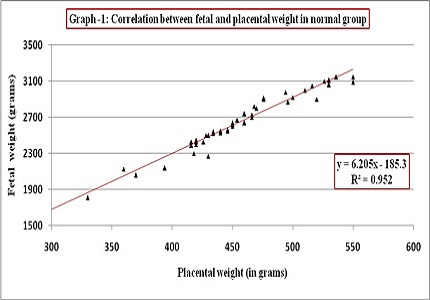Study of placental weight in normal and pre-eclamptic pregnancies and its correlation with birth weight
Abstract
Background: Placenta reflects the well being of the fetus and continuously undergoes a change in weight and function, to support the development of the fetus. The aim of this study was to assess and correlate the weight of placenta and fetal birth weight in normotensive and hypertensive pregnancies.
Materials and Methods: Fifty placenta each of normotensive and pre-eclamptic pregnancies were studied (n=100). After delivery, weight of placenta and fetal weight was recorded using weighing machine.
Results: In this study, 68.19% cases of low birth weight babies were found in pre-eclamptic group. Mean placental weight was 454.24 ± 47.52 grams and mean fetal weight was 2633.6 ± 302.2 grams in normal group. Whereas, in pre-eclamptic group, mean placental weight was 406.32 ± 59.33 grams and mean fetal weight was 2435.2 ± 280.56 grams. Mean placental and fetal weight were significantly lower in pre-eclamptic group, whereas, feto-placental weight ratio was significantly higher in pre-eclamptic group. A significant positive correlation was found between placental and fetal birth weight (r = 0.975, p<0.0001) in normal and (r = 0.971, p<0.0001) in pre-eclamptic group.
Conclusion: Pre-eclamptic pregnancies significantly reduce placental weight. These changes may be due to placental insufficiencies as a result of compromised uteroplacental blood flow in pre-eclamptic pregnancies. The present study shows a strong positive correlation between placental and fetal weight. So, the knowledge of this correlation will be tremendously useful in the early assessment of placental insufficiencies and also the state of fetal well being.
Downloads
References
2. Kliman HJ. Behind every healthy baby is a healthy placenta. Parenthood Lost. Westport, CT: Bergin & Garvey. 2001:130-131.
3. Pijnenborg R, Bland JM, Robertson WB, Brosens I. Uteroplacental arterial changes related to interstitial trophoblast migration in early human pregnancy. Placenta. 1983 Dec 31; 4(4):397-413.
4. Harding JE. The nutritional basis of the fetal origins of adult disease. International journal of epidemiology. 2001 Feb 1; 30(1):15-23. [PubMed]
5. Fowden AL, Ward JW, Wooding FP, Forhead AJ, Constancia M. Programming placental nutrient transport capacity. The Journal of physiology. 2006 Apr 1; 572(1):5-15. [PubMed]
6. Goyal M, Singh KN, Agarwal R, Patel L, Khare S. Correlation of Prenatal Ultrasound findings with Placental Pathology in High Risk Pregnancies. Journal of Evolution of Medical and Dental Sciences. 2014: 3 (3): 665-672.
7. Backes CH, Markham K, Moorehead P, Cordero L, Nankervis CA, Giannone PJ. Maternal preeclampsia and neonatal outcomes. J Pregnancy. 2011; 2011:214365. doi:10.1155/2011/214365. Epub 2011 Apr 4. Available from Pubmed: http://www.ncbi.nlm.nih.gov/pubmed/21547086.
8. Park K. Park’s textbook of Preventive and Social Medicine. 22nd ed. Jabalpur: M/S Banarsidas Bhanot India; 2013.
9. Wang Y, Lewis DF, Gu Y, Zhang Y, Alexander JS, Granger DN. Placental trophoblast-derived factors diminish endothelial barrier function. The Journal of Clinical Endocrinology & Metabolism. 2004 May 1; 89(5):2421-28.
10. Gautam G, Bhake A, Samal N, Shukla S, Gautam M, Patil P. Correlative study of placenta in Pregnancy induced hypertension cases. International Journal of Development Research. 2015 June; 5(6):4802-06.
11. Dutta KD, Dutta B. Study of human placentae associated with preeclampsia and essential hypertension in relation to foetal outcome. Journal of Obstet Gynecol India.1989; 39(6):757-63.
12. Londhe PS, Mane AB. Morphometric study of placenta and its correlation in normal and hypertensive pregnancies. International journal of pharma and Bio sciences. 2011 Oct; 2(4):429-37.
13. Udainia A, Jain ML. Morphological study of placenta in pregnancy induced hypertension with its clinical relevance. J Anat Soc India. 2001; 50(1):24-7.
14. Majumdar S, Dasgupta H, Bhattacharya K, Bhattacharya A. A study of placenta in normal and hypertensive pregnancies. J. Anat. Soc. India. 2005; 54(2):1-9.
15. Singh S, Gugapriya TS. A cross sectional morphometric study of hypertensive with normal placentae and its correlation with fetal outcome. Int J Anat Res. 2014; 2(2):437-42.
16. Salmani D, Purushothaman S, Somashekara SC, Gnanagurudasan E, Sumangaladevi K, Harikishan R, Venkateshwarareddy M. Study of structural changes in placenta in pregnancy-induced hypertension. Journal of Natural Science, Biology and Medicine. 2014 Jul 1; 5(2):352-55. [PubMed]
17. Salafia CM, Maas E, Thorp JM, Eucker B, Pezzullo JC, Savitz DA. Measures of placental growth in relation to birth weight and gestational age. American journal of epidemiology. 2005 Nov 15; 162(10):991-98. [PubMed]
18. Hosemann H. Duration of pregnancy and weight of the placenta. Archives of Gynecology. 1946; 176:453.
19. Wigglesworth. J. The gross and microscopic pathology of the prematurely delivered placenta. The Journal of obstetrics and gynaecology of the British Empire. 1962 Dec; 69:934-43.
20. Das B, Dutta D, Chakraborthy S, Nath P. Placental morphology in hypertensive disorders of pregnancy and its correlation with fetal outcome. J Obstet Gynecol India. 1996; 46(1):40-6.
21. Zakowski MI, Ramanathan S. Uteroplacental circulation and Respiratory gas exchange. In Brown B, editor. Shinder and Levinson’s Anesthesia for Obstetrics, 5th ed. Lippincott William and Wikins, a Wolters Kluwer Business; 2013. p.18. [PubMed]
22. Raghunath G, Vijayalakshmi VS. A study on the Morphology and the Morphometry of the Human Placenta and its Clinical Relevance in a population in Tamilnadu. Journal of Clinical and Diagnostic Research. 2011 Apr; 5(2):282-86. [PubMed]
23. Hamilton WJ, Girmes D. A statistical analysis of the growth of the human placenta correlated with the growth of the foetus. Journal of anatomy. 1969 Jul; 105(Pt 1):204. [PubMed]
24. Vasudeva N, Choudhary R, Anand C. Weight of the placenta, weight of the mother just before delivery and haemoglobin concentration of cord blood as an indicator to the weight of the newborn. Journal of Anatomical Society of India: 1991; 40: 141.
25. Garg K, Rath G, Sharma S. Association of birth weight, placental weight and the site of umbilical cord insertion in hypertensive mothers. J. Anat. Soc. India. 1996; 44:4.



 OAI - Open Archives Initiative
OAI - Open Archives Initiative


